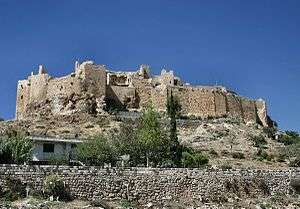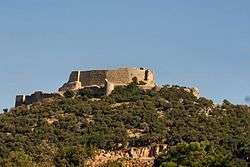Nizari–Seljuk conflicts
By the late 11th century, the Shi'a sect of Isma'ilism, propagated by the Fatimid Caliphate, had found many adherents in Persia, although the region was ruled by the staunchly Sunni Great Seljuk Empire. The bulk of the Persian Isma'ilis broke away from the declining Fatimids in 1095, forming the Nizari sect, under Hassan-i Sabbah. Based at Alamut Castle, Hassan revolted against the Seljuk order, and his followers captured many similar strongholds inside Seljuk territories. Socio-economic factors and the religious background of the population, as well as the politically decentralized nature of the Seljuk government, all facilitated the rapid spread of the revolt, while the Ismailis' effective use of strongholds, the selective removal of key enemies through assassination, and maintaining crucial alliances thwarted continuous Seljuk military efforts against their weaker opponent.
| Nizari–Seljuk conflicts | |||||||||
|---|---|---|---|---|---|---|---|---|---|
| |||||||||
| Belligerents | |||||||||
(Semi)-independent states
|
| ||||||||
| Commanders and leaders | |||||||||
| See list | See list | ||||||||
| Strength | |||||||||
| Unknown | Outnumbered | ||||||||
| Casualties and losses | |||||||||
| Minimal; many political and military elites were assassinated | Unknown; many in the massacres | ||||||||
| Many suspected Nizaris were lynched | |||||||||
The movement of the Nizaris soon lost its initial vigor and their territories were confined to isolated strongholds within the Seljuk Empire. However, the Seljuks failed to exterminate the Nizaris after prolonged wars, and tacitly accepted their existence. The Nizari government proved to be stable and even outlasted that of the Seljuks.
Sources
The bulk of the sources written by the Nizaris are lost after the Mongol invasion and during the Ilkhanate period. Much of what is known about Nizari history in Persia is based on the hostile Ilhanate-era history works Tarikh-i Jahangushay (by Ata-Malik Juvayni, Zubdah al-Tawarikh (by Abd Allah ibn Ali al-Kashani), and Jami' al-Tawarikh (by Rashid al-Din Hamadani).[1]
The participants and the nature of the conflicts

The conflicts were more complex than a simple Nizari vs Seljuk one. Even the Ismailis themselves were not unified; e.g. the Ismailis in Isfahan did not recognize the authority of Alamut. Sometimes the actual anti-Ismailism came from the local Sunni population rather than the Seljuk government, such as the massacre of the Ismailis in Isfahan in 1101. In the Seljuk dynastic conflicts, all sides were relying on Ismaili soldiers, and some Seljuk elites are known to be Ismaili converts (e.g. Iranshah ibn Turanshah) or at least to have Nizari sympathies at times (e.g. Barkiyaruq and Ridwan ibn Tutush).[2]
The general pattern of the territorial exchanges is that, whenever and wherever the Seljuk Sultan's authority diminished, the Nizaris went on the fill the gap.[2]
Hassan-i Sabbah's establishment of the Alamut state
By the final decades of the imamate of the Fatimid Caliph-Imam al-Mustansir Billah, many in Persia (then under Seljuk Empire) had converted to the Fatimid doctrine of Ismailism, while the Qarmatian branch of Ismailism was declining. Apparently, the Ismailis of Persia had already acknowledged the authority of a single Chief Da'i (missionary) based in a secret headquarters in the Seljuk capital, Isfahan. The Chief Da'i in the 1070s is recorded to be Abd al-Malik ibn Attash, a Fatimid scholar who was respected even among Sunnis.[3] In 1080, he led a revolt provoked by the increasingly severe Seljuk repressions of the Ismailis.[4]
Among da'is active under Abd al-Malik ibn Attash was Hassan-i Sabbah. The Persian Ismailis were aware of the declining power of the Fatimid Caliphate.[5] Hassan, too, must have realized that the Fatimid Caliphate (now effectively under the control of da'i al-du'at Badr al-Jamali) was unwilling and incapable of supporting the Persian Ismailis in their struggle against the Seljuks; thus Hassan decided to act independently,[6] designing a revolutionary strategy against the Seljuks.[7] Hassan had served for nine years in the service of the Fatimid da'wah in different parts of Persia and had evaluated the military power and the weaknesses of the Seljuk Empire. He concentrated his efforts in the northern mountainous region of Daylam, a traditional stronghold for Zaydi Shias which was already penetrated by the Ismaili da'wa.[8]


By 1087, Hassan had chosen the difficult-to-access and remote castle of Alamut as his future base. From his base Damghan and later Shahriyarkuh (in Tabaristan), he dispatched several da'is to the settlements in the Alamut valley to convert the locals. Hassan was eventually appointed as the Da'i of Daylam. His activities were noticed by the Seljuk vizier Nizam al-Mulk (the de facto Seljuk ruler), who ordered his son-on-law Abu Muslim, the governor of Rayy, to arrest Hassan. Hassan managed to remain hidden and arrived at Daylam in time, temporarily settling in Qazvin.[9]
Hassan captured the Alamut Castle from its Zaydi ruler Mahdi through an ingenious plan. Hassan's da'is, notably Husayn Qa'ini, had already secretly converted some of Mahdi's guards to Ismailism. From Qazvin Hassan sent one further da'i to Alamut; meanwhile, Ismailis from elsewhere infiltrated the Alamut region. Hasan then moved to Ashkawar, and then Anjirud, becoming closer to the castle, and secretly entered the castle itself on the eve of September 4, 1090, living there for awhile disguised as a children's teacher. Mahdi eventually discovered Hassan's true identity, but since most of the garrison and locals were now Ismaili converts, he was powerless. Hassan permitted Mahdi to leave peacefully and paid him via Muzaffar, a Seljuk ra'is and a secret Ismaili, 500 dinars for the castle. The seizure marks the establishment of the Ismaili state in Persia and the beginning of the so-called Alamut Period. Hassan Sabbah's policy was thus transformed into one of open revolt against the Seljuk authority.[10]
Open revolt: expansion in Rudbar and Quhistan
After the capture of Alamut, the Ismailis quickly began to construct or capture (by conversion or force) new strongholds in Rudbar, the region in which the Alamut Castle is located, situated on the bank of the Shahrud river.[11]
Hassan had sent Husayn Qa'ini to his homeland, the Quhistan region. There he was even more successful. Quhistani people had resented the rule of their oppressive Seljuk emir even more, and the Ismaili expansion there was not through secret conversion but unfolded as an open uprising. Soon the major towns of Tun (modern Ferdows), Tabas, Qa'in, and Zuzan came under the Ismaili control. Since then, the Ismaili rule in Quhistan was maintained by a local ruler titled muhtasham (محتشم) who was appointed from Alamut.[12]
The mountainous areas such as Rudbar, Quhistan, and later Arrajan chosen by the Ismaili leaders had key advantages: difficult terrain, dissatisfied population, and a local tradition of Ismaili or at least Shia loyalties.[13] Initially, the Ismailis gained support mostly in rural areas. They also received crucial support from non-Ismailis who sympathized with them merely due to socio-economic or political reasons. The Ismailis thus transformed into a formidable and disciplined revolutionary group against the Abbasid–Seljuk order.[14]
A complex set of religious and political motives was behind the revolt. The Ismailis could not tolerate the anti-Shia policies of the Seljuks, who were now the new pioneers of the Sunni Islam in what is now called the Sunni Revival, and have been the sworn enemies of the Ismailis. The early successful widespread Ismaili revolt in Persia was, less conspicuously, an expression of national Persian Muslim sentiment, a natural response given by the Persians,[15] who were Islamized but not Arabized,[16] and were conscious of their distinct identity in the Muslim World, to the domination of their lands by the Turkish people of Central Asia by the Ghaznavid, Qarakhanid, and now the Seljuk dynasty,[17] which had put an end to the so-called Iranian intermezzo.[4] The Seljuk rule was detested by various social classes. Hassan himself was reportedly openly resented the Seljuks and Turks. The Ismaili state was the first Muslim community that adopted Persian as their religious language.[18]
Economic issues further contributed to the widespread revolt. The new Seljuk social order which was based on iqta' (allotted land), which subjugated the locals under a Turk emir and his army, which also levied heavy taxes. In contrast, the Ismaili state was found to be dedicated to the ideal of social justice.[19]
Early Seljuk responses
The first bloodshed between the Ismailis and the Seljuks was possibly before the capture of Alamut. An Ismaili group performing joint prayers was arrested in Sawa by the Seljuk police chief and were freed after being questioned. The group later unsuccessfully attempted to convert a muezzin from Sawa who was active in the Seljuk capital Isfahan. Fearing that he would denounce the Ismailis, the group murdered the muezzin. Hearing the news, the vizier Nizam al-Mulk ordered the execution of their leader, Tahir, and his body was dragged through the market. Tahir was a son of a senior preacher who had been lynched by the mob in Kirman for being an Ismaili.[13]
Tūrun-Tāsh (Yūrun-Tāsh?), the emir holding the iqta' of Rudbar, quickly begin to harass and massacre the Ismailis at the foot of Alamut. Initially, the garrison considered abandoning the fortress due to a lack of supplies. Hassan, however, persuaded them to resist after claiming to receive a special message promising good fortune from the Imam al-Mustansir Billah. Yurun-Tash was eventually defeated.[20][21]
Campaigns of Sultan Malikshah and Nizam al-Mulk
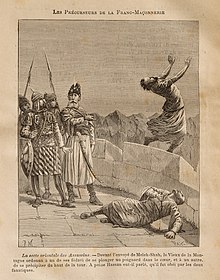
In 1092, Sultan Malikshah and his vizier Nizam al-Mulk began to send two separate armies against the Ismailis in Rudbar and Quhistan. As the Seljuk army under emir Arslan-Tash reached Alamut, the garrison consisted of only 70 men with limited supplies. Hassan-i Sabbah asked for assistance from the Qazwin-based da'i Dihdar Abu Ali Ardestani, who broke the Seljuk line with his 300 men and resupplied and reinforced the garrison of Alamut. The reinforced garrison, supported by local people, made a surprise attack in September-October 1092, routing the army of Arslan-Tash.[22]
Meanwhile, the Seljuk army against Quhistan, led by emir Qizil-Sarigh and supported by forces from Khorasan and Sistan, had concentrated their efforts against the castle of Darah, a dependency of the Ismaili castle of Mu'min-Abad.[23]
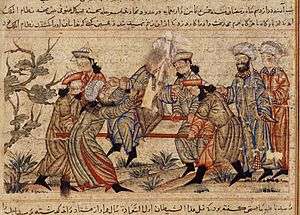
The vizier Nizam al-Mulk, who was planning further campaigns against the Ismailis, was assassinated by the latter on October 14, 1092, in western Persia. The murder is often considered to be at the instigation of Sultan Malikshah and his wife Terken Khatun, who were wary of the all-powerful vizier.[24] Malikshah himself died shortly after in November 1092 and all planned actions against the Ismailis as well as the ongoing siege of Dara was abandoned and the Seljuk soldiers dispersed, as the Seljuk soldiers traditionally owed their allegiance to the Seljuk sultan in person.[25]
[The assassination of Nizam al-Mulk] was the first of a long series of such attacks which, in a calculated war of terror, brought sudden death to sovereigns, princes, generals, governors, and even divines who had condemned Nizari doctrines and authorized the suppression of those who professed them.
Seljuk civil war of 1092–1105: further Ismaili expansion and schism
A decade-long civil war began involving the Seljuk claimants and the semi-independents Seljuk emirs who constantly shifted their allegiances. Barkiyaruq had been proclaimed as the ruler, supported by the relatives of Nizam al-Mulk and the Abbasid caliph Al-Mustazhir billah. His rivals included his half-brother Muhammad Tapar and Tutush. The latter held Syria and was killed in 1095 in battle. Fighting with Muhammad Tapar, who was backed by Sanjar, was indecisive.[26] During the chaos of the Seljuk civil war, the Ismailis consolidated and expanded their positions into many places such as Fars, Arrajan, Kirman, and Iraq, often with temporary help from Seljuk emirs.[27][2]

Hassan-i Sabbah made Alamut as impregnable as possible. Assisted by the local allies, new fortresses were seized in Rudbar. In 1093, the Ismailis took the Anjirud village and repelled an invading force there. In the same year, a 10,000-strong army consisting mostly of Sunnis of Rayy and commanded by the Hanafi scholar Abu Muhammad Za'farani was also defeated in Taliqan. Soon another raid by the Seljuk emir Anushtagin is also repelled. As a result of these victories, the local chiefs of Daylam gradually submitted to the Alamut state to receive their help. Among these was a certain Rasamuj who held the important Lamasar castle near Alamut and was trying to rebel and side with Anushtagin. In November 1096 (or 1102, per Juwayni) an Ismaili force under Kiya Buzurg-Ummid, together with Kiya Abu Ja'far, Kiya Abu Ali, and Kiya Garshasb attacked the castle and captured it. Hassan-i Sabbah then appointed Kiya Buzurg-Ummid as its governor, who transformed it into the largest and the second most important base of the Ismaili heartland of Rudbar.[28]
In 1094, the Fatimid Caliph-Imam al-Mustansir Billah died and his vizier al-Afdal Shahanshah quickly placed the young al-Musta'li on the Fatimid throne, who was subsequently recognized as the Imam by the Ismailis under the Fatimid influence (i.e. those of Egypt, much of Syria, Yemen, and western India). However, al-Mustansir Billah had originally designated Nizar as his heir; thus the Ismailis of the Seljuk territories (i.e. Persia, Iraq, and parts of Syria), now under the authority of Hassan-i Sabbah, acknowledged Nizar as their Imam. Hassan-i Sabbah severed the already weakened relations with the Fatimid organization in Cairo and effectively established an independent da'wa organization of his own on behalf of the then-inaccessible Nizari Imams.[29][30] In 1095, Nizar's revolt was crushed in Egypt and he was imprisoned in Cairo. Further revolts by his offsprings were also unsuccessful. Apparently, Nizar himself had not designated any successor. Hassan-i Sabbah was recognized as the hujja (full-representative) of the then-inaccessible Imam. Rare Nizari coins from Alamut belonging to Hassan and his two successors bear the name of an anonymous descendant of the Nizar.[31]

In 1095, the Seljuk vizier Majd al-Mulk al-Balasani who was a Twelver Shia, entrusted the citadel of Takrit in Iraq to the officer Kayqubad Daylami, an Ismaili. The citadel, one of the few open Nizari strongholds, remained in their hands for 12 years (al-Balasani was later lynched by the Seljuks).[32] Many new scattered strongholds were also seized, including Ustunawand in Damavand and Mihrin (Mihrnigar), Mansurkuh, and the strategic Girdkuh in Qumis.[33] Gerdkuh was acquired and refortified by the Seljuk ra'is Mu'ayyad al-Din Muzaffar ibn Ahmad Mustawfi, a secret Isma'ili convert and lieutenant of emir Amirdad Habashi, who in turn had acquired the fort in 1096 from Sultan Barkiyaruq. At times of dire necessity, Barkiyaruq accepted Ismailis in his forces; in 1100, near Girdkuh, 5,000 Ismailis from Quhistan and elsewhere under ra'is Muzaffar fought alongside Habashi and Barkiyaruq against Sanjar; Habashi was killed, however. Muzaffar later managed to transfer Habashi's treasure to Girdkuh and, after completing the fortifications, transferred the fortress into the Nizari possession in the same year and publicly declared himself an Ismaili.[34][35] Abu Hamza, another Ismaili da'i from Arrajan who was a shoemaker studied in Fatimid Egypt, returned to his hometown and seized at least two nearby castles.[36]
The Nizari were very successful during the reign of Barkiyaruq, especially after 1096. Besides consolidating their positions and seizing new strongholds, they managed to spread the da'wa into the towns as well as Barkiyaruq's court and army and to directly meddle in the Seljuk affairs. Despite assassination attempts against Barkiyaruq himself, the opposing Seljuk factions often blamed him for the assassination (attempt)s against their officers and accused all Barkiyaruq's soldiers of Ismailism.[37]
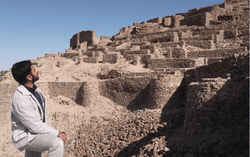
By 1100, Da'i Ahmad ibn Abd al-Malik ibn Attash, the son of Da'i Abd al-Malik ibn Attash, managed to capture the strategic fortress of Shahdiz just outside the Seljuk capital Isfahan. The da'i reportedly converted 30,000 people in the region and began collecting taxes from several nearby districts. A second fortress, Khanlanjan (Bazi) located south of Isfahan was also seized.[38]
In response to this growing Nizari power, Barkiyaruq reached an agreement with Sanjar in 1101 to eliminate all Nizaris in their subordinate regions, i.e. western Persian and Khurasan, respectively. Barkiyaruq supported massacres of the Nizaris in Isfahan and purged his army by executing suspected Ismaili officers,[39] while the Abbasid caliph al-Mustazhir persecuted suspected Nizaris in Baghdad and killed some of them, as requested by Barkiyaruq.[40] Meanwhile, Sanjar's campaign commanded by emir Bazghash against Quhistan caused much damage to the region. In 1104, another campaign in Quhistan destroyed Tabas and many Nizaris were massacred; however, no stronghold was lost and the Nizaris maintained their overall position; in 1104–1105, the Nizaris of Turshiz campaigned as far west as Rayy.[41]
The Nizaris expanded into Kirman too, and even won the Seljuk ruler of Kerman, Iranshah ibn Turanshah (1097–1101). Prompted by the local Sunni ulama' (Islamic scholars), the townspeople soon deposed and executed him.[42]
Nizari attempts to expand in Syria
Initially, most Ismailis of Syria recognized al-Musta'li as their Imam (see above). However, the vigorous Nizari da'wa soon replaced the doctrine of the declining Fatimids there—particularly in Aleppo and the Jazr region—and the Syrian Musta'li community was reduced to an insignificant element by 1130.[43] Nevertheless, the Nizari mission in Syria proved to be more difficult than in Persia: The Nizaris gained a group of strongholds only after a half-century of continuous efforts. The methods of struggle of the da'is in Syria were the same as those in Persia: seizing strongholds as bases for activity in the nearby areas, selective elimination of prominent enemies, and temporary alliances with various local chiefs to reach objectives.[44]
Background
The Nizari activity in Syria began in the early years of the 12th century or a few years earlier in the form of da'is dispatched from Alamut. Tutush I's death in 1095 and Frankish Crusader advances in 1097 caused Syria to became unstable and politically fragmented into several rival states. The decline of the Fatimids after al-Mustansir Billah's death coupled with the aforementioned political confusion of Seljuks and the Crusader threats all urged Sunnis and Shias (including Musta'lis and non-Ismailis such as Druzes and Nusayris) to shift their allegiance to the Nizari state, which boasted its rapid success in Persia.[45]
Rise and fall in Aleppo
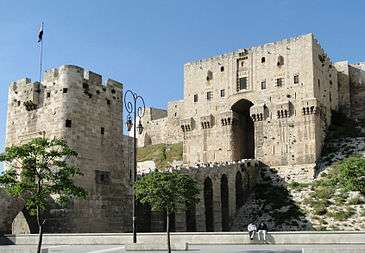
In the first phase lasted until 1113, the Nizaris under da'i al-Hakim al-Munajjim allied themselves with Ridwan, the emir of Aleppo a key political figure in Syria along with his brother Duqaq, who was the emir of Damascus. The da'i even joined Ridwan's entourage, and the Aleppine Nizaris established a Mission House (دار الدعوة dar al-dawah) in the city. Among their actions include the assassination of Janah ad-Dawla, the emir of Hims and a key opponent of Ridwan.[46]

Al-Hakim al-Munajjim died in 1103 and was replaced by the da'i Abu Tahir al-Sa'igh, also sent by Hassan-i Sabbah. Abu Tahir, too, enjoyed an alliance with Ridwan and kept using the Nizari base in Aleppo. He attempted to seize strongholds in pro-Isma'ili areas, especially the Jabal al-Summaq highlands located between the Orontes River and Aleppo. At this period, the authority over the upper Orontes valley had been shared between the assassinated Janah al-Dawlah, the Munqidhites of Shaizar, and Khalaf ibn Mula'ib, the Fatimid governor of Afamiyya (Qal'at al-Mudhiq) who had seized the fortified city from Ridwan. Khalaf ibn Mula'ib, was probably a Musta'li that had refused the Nizari alliance. Abu Tahir, with the help of local Nizaris under a ceratin Abu al-Fath of Sarmin, assassinated Khalaf in February 1106 and acquired the citadel of Qal'at al-Mudhiq by an "ingenious" plan. Tancred, the Frankish regent of Antioch besieged the city, but he was unsuccessful. A few months later in September 1106, he besieged the city again and captured it with the help of Khalaf's brother, Mus'ab ibn Mula'ib. Abu al-Fath was executed, but Abu Tahir ransomed himself and returned to Aleppo.[47][48]
In 1111, the Nizari forces joined Ridwan as he closed Aloppo's gate to the expeditionary force of Mawdud, the Seljuk atabeg of Mosul, who had come to Syria to fight the Crusaders. However, in his final years, Ridwan retreated from his earlier alliances with the Nizaris due to the determined anti-Nizari campaign of Muhammad Tapar (see below) coupled with increasing unpopularity of the Nizaris among the Sunnis of Aleppo. Mawdud was assassinated in 1113, but it is uncertain who was actually behind the attack.[47][49]
Ridwan died shortly after and his young son and successor Alp Arslan al-Akhras initially supported the Nizaris, even ceding the Balis fortress on the Aleppo–Baghdad road to Abu Tahir. During his anti-Nizari campaign, the Seljuq sultan Muhammad Tapar as well as Sa'id ibn Badi', the ra'is of Aleppo and militia (al-ahdath) commander, turned Alp Arslan against the Nizaris. In the subsequent persecution led by Sa'id, Abu Tahir and many other Nizaris in Aleppo were executed[50] and others dispersed[51] or went underground.[47][52] A attempt by Nizaris of Aleppo and elsewhere to seize the Shaizar castle is defeated by the Munqidhites.[53]
Thus Nizaris failed to gain any permanent base in Syria, but they managed to create contacts and convert many people, especially in the Jabal al-Summaq, the Jazr, and Banu Ulaym's territories between Shayzar and Sarmin.
Rise and fall in Damascus
After the execution of his predecessor Abu Tahir al-Sa'igh and the uprooting of the Nizaris in Aleppo, Bahram al-Da'i was sent by Alamut in an attempt to expand the resurrect the Nizari cause in Syria.[47]
In 1118, Aleppo was captured by Ilghazi, the Artuqid prince of Mardin and Mayyafariqin. The Nizaris of Aleppo demanded Ilghazi cede al-Sharif Castle (قلعة الشريف) to them, but Ilghazi had the castle dismantled and pretended that the order was given earlier. The demolition was conducted by qadi Ibn al-Khashshab, who was earlier involved in a massacre of the Nizaris (he was later assassinated by the Nizaris in 1125). In 1124, Ilghazi's nephew, Balak Ghazi, the (nominal) governor of Aleppo, arrested the Bahram's representative there and forced the Nizaris to leave the city. [54]

Thus, Bahram focused on Southern Syria as recommended by his supporter, Ilghazi. The da'i resided there in secret and practiced his missionary activities in disguise. Supported by Ilghazi, he managed to obtain the official protection of the Burid ruler Tughtigin, atabeg of Damascus, whose vizier al-Mazadaqani had become a reliable Nizari ally. At this point in 1125, Damascus was under threats of the Frankish Crusaders under Baldwin II of Jerusalem, and Isma'ilis from Homs and elsewhere had earlier joined Tughtigin's troops and were noted for their courage, in the Battle of Marj al-Saffar against the Franks in 1126.[55][56] Bahram apparently helped in the assassination of Tughtigin's enemy Aqsunqur al-Bursuqi, the governor of Mosul. Toghtekin thus welcomed Bahram. Al-Mazadaqani persuaded Toghtekin to give a Mission House in Damascus and the frontier fortress Baniyas (the Nimrod Fortress) to Bahram, who refortified the stronghold and made it his military base, performing extensive raids from there and possibly capturing more places. By 1128, their activities had become so formidable that "nobody dared to say a word about it openly".[55][57][58]
Bahram was killed in 1128 while fighting local hostile tribes in Wadi al-Taym.[59][55] The Fatimids in Cairo rejoiced after receiving his head.[60]
He was succeeded by Isma'il al-Ajami who kept using Baniyas and followed Bahram's policies. Tughtigin's successor and son, Taj al-Muluk Buri, initially continued to support the Nizaris, but the scenario in Aleppo repeated here in Damascus: Buri suddenly shifted his policy at the right moment, killing al-Mazdaqani and ordering a massacre of all Nizaris, which was conducted by al-ahdath (militia) and the Sunni population, who killed around 6,000 Nizaris. Buri was instigated by the prefect of Damascus (ra'is al-shihna), Mufarrij ibn al-Hasan ibn al-Sufi, and the city's military governor (ra'is al-shurta), Yusuf ibn Firuz.[61] Isma'il al-Ajami surrendered Baniyas to the advancing Franks during the Crusade of 1129 and died in exile among the Franks in 1130. Despite elaborate security measures taken by Buri, he was struck in May 1131 by fida'is from Alamut and died of his wounds a year later; nevertheless, the Nizari position in Damascus was already lost forever.[62]
Sultan Muhammad Tapar's campaigns

Barkiyaruq died in 1105 and Muhammad Tapar, along Sanjar who acted as his eastern viceroy, became the unchallenged Seljuk sultan who reigned the stabilized empire until 1118.[63][13] The Nizari expansion had probably been already checked by Barkiyaruq and Sanjar, but they still hold their ground and were posing threats from Syria to eastern Persia and in the Seljuk capital of Isfahan itself.[64]
Muhammad Tapar launched a series of campaigns against the Nizaris and checked their expansion within two years after his accession. A siege of Takrit failed to capture the citadel after several months, but the Nizaris under Kayqubad were also unable to keep it and ceded it to an independent local Twelver Shia Arab ruler, the Mazyadid Sayf al-Dawla Sadaqa. At the same time, Sanjar attacked Quhistan, but the details are unknown.[65]
Muhammad Tapar's main campaign was against Shahdiz which was threatening his capital Isfahan. He eventually captured Shahdiz in 1107 after a dramatic siege involving many negotiations;[2] some of the Ismailis safely withdrew according to an agreement, while a small group kept fighting. Their leader, Da'i Ahmad ibn Abd al-Malik ibn Attash, was captured and executed together with his son. The fortress of Khanlanjan was also probably destroyed, and the Ismaili presence in Isfahan was brought to an end. Muhammad Tapar issued a fathnama (فتحنامه, a victory proclamation) after the capture of Shahdiz.[2]
Probably soon after destroying Shadiz, Seljuk forces under Muhammad Tapar's atabeg of Fars, Fakhr al-Dawla Chawli, destroyed the Nizari fortresses in Arrajan[66] in a surprise attack as he pretended to be preparing for an attack against his neighbor Bursuqids.[67] Little is recorded about Nizaris in the area after this event.[68]
In 1106-1109, Muhammad Tapar sent an expeditionary force under his vizier Ahmad ibn Nizam al-Mulk (whose father Nizam al-Mulk and brother Fakhr al-Mulk had been assassinated by the Nizaris), accompanied by emir Chawli, against the Nizari heartland of Rudbar. The campaign devastated the area but failed to capture Alamut, and the Seljuks withdrew. Muhammad Tapar unsuccessfully attempted to receive assistance from the Bavandid ruler Shahriyar IV ibn Qarin.[69][13]
In 1109, Muhammad Tapar began another campaign against Rudbar. The Seljuks had realized that Alamut is impregnable to a direct assault, so they began a war of attrition by systematically destroying the crops of Rudbar for eight years and engaging in sporadic battles with the Nizaris. In 1117/1118, atabeg Anushtagin Shirgir, the governor of Sawa, took up the Seljuk command and began the siege of Lamasar on June 4, 1117, and Alamut on July 13. The Nizaris were at a difficult position; Hassan-i Sabbah and many others had sent their wives and daughters to Girdkuh and elsewhere.[70] The Nizari resistance amazed their adversary, which was being continually reinforced by other Seljuk emirs. In April 1118, the news of Muhammad Tapar's death caused the Seljuks to withdraw while reportedly being on the verge of victory; many men were lost in the retreat, and the Nizaris obtained much supplies and weapons.[71] Apparently, the vizier Abu al-Qasim Dargazini, who was allegedly a secret Nizari, procured the new Seljuq Sultan, Mahmud II, to withdraw the forces of Shirgir, and later poisoned the mind of the Sultan against Shirgir, who had the latter imprisoned and executed.[13]
Muhammad Tapar's campaign thus ended as a stalemate, with the Seljuks failing to reduce the Nizari strongholds and the Nizari revolt losing its initial effectiveness.[72][73]
Unable to repel the concerted Seljuk forces, the Nizaris continued to rely on assassinations of senior Seljuk leaders, such as Ubayd Allah ibn Ali al-Khatibi (qadi of Isfahan and the leader of the anti-Ismaili movement there) in 1108-1109, Sa'id ibn Muhammad ibn Abd al-Rahman (qadi of Nishapur), and other bureaucrats and emirs. Ahmad ibn Nizam al-Mulk, who led the expedition against Alamut, survived an assassination attempt in Baghdad, though he was wounded.[2][13] In 1116/1117, the Seljuk emir of Maragha, Ahmadil ibn Ibrahim al-Kurdi, was assassinated by the Nizaris in a large assembly in presence of Sultan Muhammad Tapar—a blow to the prestige of the Seljuks.[74]
After Sultan Muhammad Tapar: toward stalemate
The Nizaris used an opportunity to recover during another destructive civil war among the Seljuks after Sultan Muhammad's death.[13]
For the rest of the Seljuk period, the situation was a virtual stalemate and a tacit mutual acceptance emerged between the Nizaris and the Sunni rulers. The great movement to establish a new millennium in the name of the hidden Imam had been reduced into regional conflicts and border raids, and the Nizari castles had been turned into centers of small local sectarian dynasties. Seljuk campaigns after Sultan Muhammad were mostly half-hearted and indecisive, while the Nizaris lacked the initial strength to repeat successes such as the capture of Shahdiz. The Seljuk sultans did not consider the Nizaris, who were now mostly in remote fortresses, a threat to their interests. The Seljuks even used the Nizaris for their assassinations, or at least used their notoriety for the use of assassination to cover up their own assassinations; such as those of Aqsunqur al-Ahmadili and the Abbasid Caliph al-Mustarshid in 1135, probably by Sultan Mas'ud.[13][2] The number of the recorded assassinations dwindles after Hassan-i Sabbah's reign.[13] The Nizaris eventually abandoned the tactic of assassination, because political terrorism was considered reprehensible by the common people.[75]
The nature of Nizari–Seljuk relations gradually changed in this period: the ultimate Nizari aims were no longer renounced, but their subversion in inner Seljuk territories was halted and they began to consolidate the remote territories they held instead. Small (semi)-independent Nizari states were established, which participated in local alliances and rivalries.[13]
Sultan Mahmud II and Sultan Sanjar
Muhammad Tapar was succeeded by his son Mahmud II who ruled from 1118 until 1131 over western Persia and (nominally) Iraq, but he faced many claimants. Sanjar, who held Khorasan since 1097, was generally recognized as the head of the Seljuk family. Some Nizari forces joined Sanjar's forces in his invasion of Mahmud II's territories in 1129. The latter was defeated in Sawa and much of northern Persia, including Tabaristan and Qumis, which was penetrated by the Nizaris, came under Sanjar's rule. Mahmud II's brother, Tughril, later rebelled and retook Gilan, Qazwin, and other districts.[76]
The final years of Hassan-i Sabbah were peaceful and were mostly spent in consolidating the Nizari position, including the recapture of strongholds in Rudbar that had been lost in Shirgir's campaign, as well as intensifying the da'wa in Iraq, Adhurbayjan, Gilan, Tabaristan, and Khurasan. These successes, and those of the later decades, are partly attributed to the peaceful or friendly relations of the Nizaris with Sanjar. Juwayni has told a famous story about Hassan-i Sabbah sending a eunuch to place a dagger into the ground beside the Sultan's bed once he is asleep; Afterward, Sanjar established good relations with the Nizaris. Juwayni had also seen several manshurs (منشور, "decrees") by Sanjar at the library of Alamut, in which the sultan had conciliated the Nizaris. Sanjar reportedly paid the Nizaris an annual of 3,000-4,000 dinars from taxes of the Qumis region, as well as allowing them to levy tolls from the caravans passing beneath Girdkuh in the Khurasan Road.[77]
Campaigns against Kiya Buzurg-Ummid
In 1126, two years after Kiya Buzurg-Ummid succeeded Hasan Sabbah as the head of the Alamut state, Sultan Sanjar sent his vizier Mu'in al-Din Ahmad al-Kashi to attack the Nizaris of Quhistan with orders to massacre them and confiscate their properties. The casus belli is uncertain; it may have been motivated by a perceived weakness of the Nizaris after Hassan's death. The campaign ended with limited success. In Quhistan, a Seljuk victory in the village of Tarz (near Bayhaq) and a successful raid on Turaythith has been recorded. In the same year, Sultan Mahmud sent an army led by Shirgir's nephew, Asil, against Rudbar; this campaign was even less successful and was repelled. Another Seljuk campaign launched with local support against Rudbar was also defeated and a Seljuk emir, Tamurtughan, was captured. He was released later as requested by Sanjar. At the same time or shortly after the campaign in Quhistan, the Nizaris lost Arrajan; after this point, little is recorded about them in Arrajan, and therefore, in Khuzestan and Fars.[13][78]
The Nizaris were quick to take revenge—the commander of the Quhistan's campaign, vizier al-Kashi, was assassinated in March 1127 by two fida'is who had infiltrated into his household and gained his confidence. According to Ibn al-Athir, Sultan Sanjar launched a punitive expedition against Alamut in which 10,000 Nizaris were killed, but this is probably an invention.[13][79]

At the end of Buzurg-Ummid's reign, the Nizaris were stronger than before. Several fortresses (including Mansur) were captured in Taliqan, while several new ones were constructed, including Sa'adatkuh, and most famously the major stronghold Maymun-Diz in Rudbar. In 1129, a Nizari army (probably from Quhistan) raided Sistan.[80]
In May of the same year, Sultan Mahmud moved to make peace by inviting an envoy from Alamut. The envoy, Khwaja Muhammad Nasihi Shahrastani, and his colleague were lynched by the mobs in Isfahan after visiting the Sultan. The Sultan apologized but refused Buzurgummid's request to punish the murderers. In response, the Nizaris attacked Qazwin, killing some and taking much booty; when the Qazwinis fought back, the Nizaris assassinated a Turkish emir, resulting in their withdrawal. This conflict marked the beginning of a long-lasting feud between the Qazwinis and the Nizaris of Rudbar. Sultan Mahmud himself also attacked Alamut, but he failed. Another army sent from Iraq against Lamasar also fails to achieve much.[13][81]
Sultan Mas'ud, Muhammad ibn Buzurg-Ummid, and later lords of Alamut

In 1131, Sultan Mahmud II died. In the subsequent dynastic struggles, some of the emirs somehow involved the Abbasid Caliph Al-Mustarshid in the conflicts against Sultan Mas'ud. In 1139 (1135?), Sultan Mas'ud captured the caliph, together with his vizier and several dignitaries, near Hamadan, treated him with respect, and brought him to Maragha; however, while the caliph and his companions were in the royal tentage, he let a large group of Nizaris enter the tent and assassinate Al-Mustarshid and his companions; the caliph was stabbed many times. Rumors arose suggesting involvement (or at least deliberate negligence) of Sultan Mas'ud and even Sultan Sanjar (the nominal ruler of the empire). In Alamut, celebrations were held for seven days.[13][82][83] The governor of Maragha was also assassinated shortly before the arrival of the caliph. Several other Seljuk elites were also assassinated during the reign of Kiya Buzurg-Ummid in Alamut, including a prefect of Isfahan, a prefect of Tabriz, and a mufti of Qazvin—the list is quite shorter than that of Hassan Sabbah's reign.[13]
Al-Mustarshid's son and successor, al-Rashid, also became involved in the Seljuk dynastic conflicts, and after being deposed by an assembly of Seljuk judges and jurists, and was assassinated by the Nizaris in 5 or 6 June 1138 when he arrived in Isfahan to join his allies. His death, too, was celebrated in Alamut as the first victory for the new Lord of Alamut, Muhammad ibn Buzurg-Ummid. However, a great massacre of the Nizaris occurred at Isfahan. During the latter's reign, the Seljuk Sultan Da'ud, who had persecuted the Nizaris of Adharbaijan, was assassinated in Tabriz in 1143 by four Syrian(!) fida'is. They were allegedly sent by Zangi, the ruler of Mosul, who feared that the Sultan may depose him. An attack by Sultan Mas'ud against Lamasar and other places in Rudbar was repelled in the same year.[13][84][85]
The Nizari influence extended to Georgia (where a local ruler was assassinated) and their territories were expanded into Daylaman and Gilan, where new fortresses, namely Sa'adatku, Mubarakkuh, and Firuzkuh, chiefly through the efforts of the commander Kiya Muhammad ibn Ali Khusraw Firuz. Nizari operations were often led by Kiya Ali ibn Buzurg-Ummid, brother of Muhammad. They also made efforts to penetrate Ghur (in present-day Afghanistan).[13][86]
Other assassinations recorded during Muhammad's reign include an emir of Sultan Sanjar and one of his associates, Yamin al-Dawla Khwarazmshah (a prince of the Khwarazmian dynasty, in 1139/1140), a local ruler in Tabaristan, a vizier, and the qadis of Quhistan (in 1138/1139), Tiflis (in 1138/1139), and Hamadan (in 1139/1140), who had authorized the executions of Nizaris. Nevertheless, the stalemate mostly continued during Muhammad ibn Buzurg-Ummid's reign.[13][87]
The reduced number of assassinations during Muhammad's reign comes with the fact that the Nizaris were mostly occupied with building fortresses and handling local conflicts with neighboring territories, in particular raiding and counter-raidings between the Nizari heartland and their neighbor Qazwin. Two notable regional enemies of the Nizaris in this period were (1) Shah Ghazi Rustam (after the assassination of his son Girdbazu), the Bawandid ruler of Tabaristan and Gilan and (2) Abbas, the Seljuk governor of Rayy, both of whom are alleged to have built towers made of the skulls of Nizaris they massacred. Abbas was killed on Sultan Mas'ud's order and at Sanjar's request, itself after an entreaty made by a Nizari emissary; this suggests another period of truce between Sanjar and the Nizaris. Elsewhere conflicts are also reported with Sultan Sanjar, for example, the latter's attempt to restore Sunni Islam in a Nizari base in Quhistan: Al-Amid ibn Mansur (Mas'ud?), the governor of Turaythith, had submitted to the Quhistani Nizaris, but his successor Ala al-Din Mahmud appealed to Sanjar for restoring the Sunni rule there. Sanjar's army led by emir Qajaq was defeated. Soon after, another emir of Sanjar, Muhammad ibn Anaz, began to conduct "personal" raids against the Nizaris of Quhistan, probably with Sanjar's approval, until at least 1159, i.e., after Sanjar's death. In Nizari castles, the leadership was often dynastic, and thus the nature of most such conflicts are limited to that certain dynasty.[13][88]
%2C_minted_in_Alamut.jpg)
The reigns of Hassan II and his son Muhammad II at Alamut were mostly peaceful, except some raids and the assassination of Adud al-Din Abu al-Faraj Muhammad ibn Abdallah, the prominent vizier of the Abbasid caliph al-Mustadi, in 1177/1178, shortly after the fall of the Fatimids by Saladin six years earlier.[13]
Nizaris establish themselves in Jabal Bahra', Syria
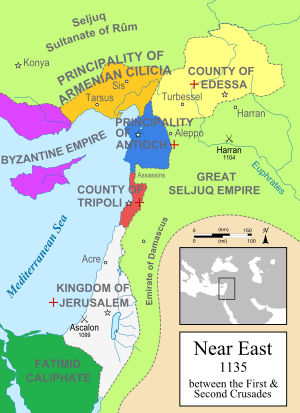
The Fatimids declined following the Nizari-Musta'li schism and subsequently many in Syria rallied toward the Nizaris.[89] In this period of Nizari activity in Syria from 1130 until 1151, they gain several strongholds in the Jabal Bahra' (today called the Syrian Coastal Mountain Range).[90]
In the third phase the Nizaris apparently quickly reorganized under da'i Abu al-Fath and transferred their activities outside the cities and penetrated to the mountainous region of Jabal Bahra' following the Crusaders' failure to capture this region. Little is known about this period. They obtained their first fortress, al-Qadmus, by purchasing it from the governor of al-Kahf Castle, Sayf al-Mulk ibn 'Amrun, in 1132–1133. The latter's son, Musa, sold al-Kahf itself to the Nizaris to prevent the castle's fall to his cousins. In 1136–1137, the Frankish-occupied Khariba was captured by local Nizaris. In 1140–1141, the Nizaris captured Masyaf by killing Sunqur, who commanded the fort on behalf of the Banu Munqidh of Shayzar. Khawabi, Rusafa, Maniqa, and Qulay'a were captured around the same time. A few decades later, William of Tyre reports the number of these castles at ten and the Nizari population there at 60,000.[91]
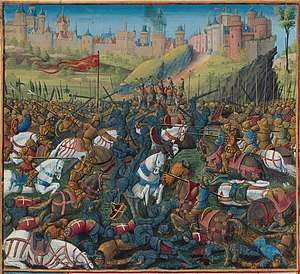
The Nizari enemies at this point were the local Sunni rulers and the Crusader Latin states of Antioch and Tripoli, and the Turkish governors of Mosul; the latter was in the strategic region between the Syrian and Persian Nizari centers. In 1148, the Zengid emir Nur al-Din Mahmud abolished the Shia forms of prayer Aleppo, which was considered as an open war against the Ismailis and Shia Aleppines. A year later a Nizari contingent assisted Prince Raymond of Antioch in his campaign against Nur al-Din; both Raymond and the Nizari commander Ali ibn Wafa' were killed in the subsequent battle at Inab in June 1149.[92]
A succession dispute occurred after the death of Shaykh Abu Muhammad, the head of the Nizari da'wa in Syria. Eventually, the leadership was passed to Rashid al-Din Sinan by orders from Alamut. He managed to consolidate the Nizari position in Syria by adopting appropriate policies towards the Crusaders, Nur al-Din, and Saladin.[93]
Aftermath
Hassan Sabbah's objective was not realized, but nor was that of the Seljuks who intended to uproot the Nizaris. Hassan, however, managed to establish a Nizari state. The confrontation became a stalemate by around 1120.[94]
The Nizari state gradually weakened due to prolonged conflicts with too many superior enemies. The indecisive Nizari policy against the Mongols also contributed to their fall after the Mongol invasion of Persia. Deprived of political power, the Nizaris were scattered in the many lands and lived until the present day as religious minorities.[95]
The Nizari state enjoyed a stability that was uncommon in other principalities of the Muslim World in that period. These are attributed to their distinct methods of struggle, the genius of their early leaders, their strong solidarity, the sense of initiative of their local leaders, their appeal to outstanding individuals, as well as their strong sense of mission and total dedication to their ultimate ideal, which they maintained even after their initial failure against the Seljuks.[96]
Conflicts continued between the Alamut and the people of Qazwin, the rulers of Tabaristan, and after the decline of the Seljuks, the Khwarezmshahs. The Ismailis of Quhistan were engaged against the Ghurids, while those of Syria gradually became independent of Alamut.[4]
Nizari methods
Decentralized strongholds
The struggles of the Persian Ismailis was characterized by distinctive patterns and methods. Modeled and named after the hijra (emigration) of the Prophet Muhammad from Mecca to Medina, the Nizaris established headquarters called dar al-hijra in Iraq, Bahrain, Yemen and Maghreb. These were strongholds serving as defensible places of refuge as well as local headquarters for regional operations. These strongholds of the da'is were independent but cooperated with each other. This coordinated decentralized model of revolt proved to be effective since in the structure of the Seljuk Empire, especially after Malikshah, the authority was locally distributed and the empire was rather in the hands of numerous emirs and commanders (see iqta'); thus there was no single target to be confronted by a strong army, even if the Ismailis could mobilize such an army.[97]
The Ismaili fortresses in Rudbar were able to withstand long sieges: in addition to the inaccessibility of the region itself, the fortifications were built on rocky heights and were equipped large storehouses and elaborate water supply infrastructure.[98]
Assassination
The aforementioned structure of the Seljuk Empire as well as the vastly superior Seljuk military also suggested the Nizaris employing targeted assassination to achieve their military and political goals, which they effectively did to disrupt the Seljuk Empire.[99][75] They later owed their name, Assassin, to this technique, and all the important assassinations in the region were usually attributed to them.[100]
Although many medieval anti-Nizari legends were developed with respect to this technique, few historical information is known regarding the selection and training of the fida'is (Persian: فدائی fidā'ī, plural فدائیان fidā'iyān) All ordinary Persian Ismailis, who called each other as "comrade" (رفیق rafīq, plural رفیقان rafīqān) were supposedly ready to conduct any task for the Ismaili community. However, in the late Alamut period, the fida'is probably formed a special corps. They had a strong group sentiment and solidarity.[101]
The Nizaris viewed their assassinations, in particular those of the well-guarded, notorious targets which required a sacrificial assassination by a fida'i, as acts of heroism.[102] Rolls of honors containing their names and their victims were kept at Alamut and other fortresses.[103][13] They saw a humane justification in this method, as the assassination of a single prominent enemy served to save the lives of many other men on the battlefield. The missions were performed publicly as much as possible in order to intimidate other enemies.[104] The assassination of a town's prominent figure often triggered the Sunni population to massacre all (suspected) Ismailis in that town.[105]
References
- Daftary 2007, p. 303-307
- Peacock, A. C. S. (2015). Great Seljuk Empire. Edinburgh University Press. p. 75. ISBN 978-0-7486-9807-3.
- Daftary 2007, p. 310-311
- B. Hourcade, “ALAMŪT,” Encyclopædia Iranica, I/8, pp. 797-801; an updated version is available online at http://www.iranicaonline.org/articles/alamut-valley-alborz-northeast-of-qazvin- (accessed on 17 May 2014).
- Daftary 2007, p. 310-311
- Daftary 2007, p. 313-314
- Daftary 2007, p. 301
- Daftary 2007, p. 313-314
- Daftary 2007, p. 314
- Daftary 2007, p. 314-316
- Daftary 2007, p. 318
- Daftary 2007, p. 318-319
- Lewis, Bernard (2011). The Assassins: A Radical Sect in Islam. Orion. pp. 53—. ISBN 978-0-297-86333-5.
- Daftary 2007, p. 317
- Daftary 2007, p. 316
- Iran in History Archived 2007-04-29 at the Wayback Machine by Bernard Lewis.
- Daftary 2007, p. 316
- Daftary 2007, p. 316
- Daftary 2007, p. 316
- Alamut was later nicknamed baldat al-iqbāl (بلدة الإقبال, literally "the city of good fortune") after this incident.
- Daftary 2007, p. 318
- Daftary 2007, p. 319
- Daftary 2007, p. 319
- Daftary 2007, p. 319
- Daftary 2007, p. 320
- Daftary 2007, p. 320
- Daftary 2007, p. 320
- Daftary 2007, p. 324
- Those of the easternmost areas of the Ismaili world, notably Ghazna and the Oxus valley, remained outside of either The Nizari or Musta'li influence for a long time.
- Daftary 2007, p. 325
- Daftary 2007, p. 326
- Daftary 2007, p. 321-324
- Daftary 2007, p. 320-321
- Daftary 2007, p. 320-321
- Daftary, Farhad. "GERDKŪH – Encyclopaedia Iranica". www.iranicaonline.org. Retrieved 1 April 2020.
- Daftary 2007, p. 321
- Daftary 2007, p. 329-330
- Daftary 2007, p. 329-330
- Daftary 2007, p. 329-330
- رازنهان, محمدحسن; خلیلی, مهدی. "تحلیلی بر روابط سیاسی اسماعیلیان نزاری با خلافت عباسی" (PDF). نشریه مطالعات تقریبی مذاهب اسلامی (فروغ وحدت) (in Persian). 0 (32): 25. ISSN 2252-0678.
- Daftary 2007, p. 329-330
- Daftary 2007, p. 321
- Daftary 2007, p. 325
- Daftary 2007, p. 331-332
- Daftary 2007, p. 331-332
- Daftary 2007, p. 331-333
- Mirza, Nasseh Ahmad (1997). Syrian Ismailism: The Ever Living Line of the Imamate, AD 1100-1260. Psychology Press. p. 8-12. ISBN 9780700705054.
- Daftary 2007, p. 333-334
- Daftary 2007, p. 334
- Among the executed were Abu Tahir himself, da'i Isma'il, and a rother of al-Hakim al-Munajjim.
- Including the commander of the Nizari armed forces in Aleppo, Husam al-Din ibn Dumlaj, who fled to al-Raqqa, and the commandant of the Balis fort, Ibrahim al-Ajami, who fled to Shaizar.
- Daftary 2007, p. 334
- Daftary 2007, p. 334
- Daftary 2007, p. 349
- Gibb, N. A. R., Editor (1932), The Damascus Chronicle of the Crusades. Extracted and translated from the Chronicle of ibn al-Qalānisi, Luzac & Company, London, pp.174-177, 179-180, 187-191
- Daftary 2007, p. 349
- Daftary 2007, p. 349
- Fodor's Israel. Fodor's Travel. 1999. p. 290. ISBN 978-0-679-00097-6.
- Setton, Kenneth Meyer; Baldwin, Marshall W. (1969). A History of the Crusades. Univ of Wisconsin Press. p. 111-120. ISBN 978-0-299-04834-1.
- Daftary 2007, p. 349
- Daftary 2007, p. 347-348
- Daftary 2007, p. 349
- Daftary 2007, p. 320-321
- Daftary 2007, p. 335
- Daftary 2007, p. 335-336
- Daftary 2007, p. 337
- رحمتی, محسن (2018). خاندان برسقی و تحولات عصر سلجوقی (PDF) (in Persian).
- Daftary 2007, p. 337
- Daftary 2007, p. 337
- This practice became common among the Nizari leaders thereafter.
- Daftary 2007, p. 337
- Daftary, Farhad (2001). Mediaeval Isma'ili History and Thought. Cambridge University Press. p. 199. ISBN 9780521003100.
- Boyle, J. A., Editor, The Cambridge History of Iran, Volume 5: The Saljuq and Mongol Periods, Cambridge University Press, 1968, pgs. 118-119
- رازنهان, محمدحسن; خلیلی, مهدی. "تحلیلی بر روابط سیاسی اسماعیلیان نزاری با خلافت عباسی" (PDF). نشریه مطالعات تقریبی مذاهب اسلامی (فروغ وحدت) (in Persian). 0 (32): 26. ISSN 2252-0678.
- Barash, David P.; Webel, Charles P. (2008). Peace and Conflict Studies. SAGE. p. 53. ISBN 978-1-4129-6120-2.
- Daftary 2007, p. 338
- Daftary 2007, p. 342
- Daftary 2007, p. 345
- Daftary 2007, p. 345
- Daftary 2007, p. 345-346
- Daftary 2007, p. 345-346
- Cook, David (1 January 2012). "Were the Ismāʿīlī Assassins the First Suicide Attackers? An Examination of Their Recorded Assassinations". The Lineaments of Islam: 97–117. doi:10.1163/9789004231948_007.
- Turko-Mongol Rulers, Cities and City Life. BRILL. 2013. p. 153. ISBN 978-90-04-25700-9.
- Wasserman, James (2001). The Templars and the Assassins: The Militia of Heaven. Simon and Schuster. p. 102. ISBN 978-1-59477-873-5.
- Daftary 2007, p. 355-357
- Daftary 2007, p. 355-356
- Daftary 2007, p. 355-356
- Daftary 2007, p. 357
- Daftary 2007, p. 349-350,352
- Daftary 2007, p. 332
- Daftary 2007, p. 349-350,352
- Daftary 2007, p. 349-350,352
- Daftary 2007, p. 355-356
- Daftary 2007, p. 301
- Daftary 2007, p. 303
- Daftary 2007, p. 355
- Daftary 2007, p. 326-327
- B. Hourcade, “ALAMŪT,” Encyclopædia Iranica, I/8, pp. 797-801; an updated version is available online at http://www.iranicaonline.org/articles/alamut-valley-alborz-northeast-of-qazvin- (accessed on 17 May 2014).
- Daftary 2007, p. 328
- Daftary 2007, p. 328
- Daftary 2007, p. 328-329
- Daftary 2007, p. 328
- Daftary 2007, p. 328
- Daftary 2007, p. 28
- Daftary 2007, p. 329
- Daftary, Farhad (2007). The Isma'ilis: Their History and Doctrines (2nd, revised ed.). Cambridge University Press. ISBN 978-1-139-46578-6.

